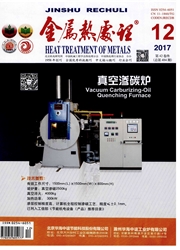

 中文摘要:
中文摘要:
通过对7075铝合金进行不同温度(450~495℃)的固溶处理,研究了固溶温度对该合金的硬度、室温拉伸性能及高周疲劳性能的影响,并用光学显微镜和扫描电镜对合金显微组织及疲劳断口进行观察。结果表明,随着固溶温度的升高,合金组织发生不同程度的静态再结晶和晶粒长大,合金硬度和拉伸强度均先升高后降低,480℃固溶处理后达到最高;疲劳极限随着固溶温度的升高先降低后升高,495℃固溶处理后达到最高。疲劳裂纹主要起源于粗大残留相处,扩展过程中产生的二次裂纹可降低裂纹扩展的驱动力,进而降低合金的裂纹扩展速率,提高合金疲劳性能。
 英文摘要:
英文摘要:
Effects of solution temperatures( 450-495 ℃) on hardness, room-temperature tensile properties and high cycle fatigue performance of 7075 aluminum alloy were investigated. Microstructures and fractographies under different solution temperatures were observed using optical microscope( OM) and scanning electron microscope( SEM). The results show that with the increase of solution temperature,different degrees of static recrystallization take place and grain growth ocures in the alloy,and meanwhile,the hardness and tensile strength first increase and then decrease. Moreover,the highest hardness and tensile strength can be obtained when the solution temperature is about480 ℃. The fatigue limit first increases and then decreases with the increase of solution temperature,and the highest fatigue limit can be reached when the alloy is solution treated at 495 ℃. It is found that most of the fatigue cracks initiate at coarse residual phases. Meanwhile,secondary cracks generated in the fatigue crack propagation regions can reduce the driving force and rate of crack propagation,therefore,fatigue performance can be improved.
 同期刊论文项目
同期刊论文项目
 同项目期刊论文
同项目期刊论文
 期刊信息
期刊信息
